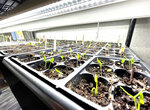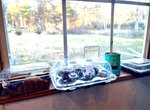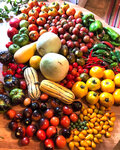Coastal southern Alabama offers home gardeners a golden opportunity to jumpstart their growing season as early as January. With mild winters and a humid subtropical climate, this region is a perfect …
This item is available in full to subscribers.
Please log in to continue |



Coastal southern Alabama offers home gardeners a golden opportunity to jumpstart their growing season as early as January. With mild winters and a humid subtropical climate, this region is a perfect haven for cultivating heat-loving crops.
In this coastal seed starting guide, we'll delve into the nuances of successful seed starting, choosing tomatoes and peppers that perform well in our grow zone, along with an exploration of other crops that can be seed started this month and that thrive in the warm and humid conditions of Coastal southern Alabama.
Coastal Baldwin County is unique in that our climate is characterized by mild winters and hot, humid summers. January temperatures ranging from 40 to 60 degrees Fahrenheit provide an ideal setting for initiating the seed starting process within your home, greenhouse, garage or shed with minimal heating needs.
Not all vegetables grow well in our hot humid summers. January is the time to begin your seed starting journey in our grow zone.
Now is the time to begin selecting and seed starting tomatoes and peppers (plus more). Here is a quick guide for picking the right seed varieties.
Opt for heat-tolerant varieties, specifically ones that mention performing well under hot humid conditions.
While disease-resistant options are advantageous, they are not foolproof in our humid climate, which brings about blight and fungal issues. However, they do provide a delay in the onset of diseases.
Tip: To help combat fungal issues with tomatoes, don't water from above. Only water from below to not add more water content to their leaves that our humid air already supplies. Keep dirt from splashing up onto your tomato leaves by mulching or adding a protective layer such as cardboard. A majority of our diseases are soil-borne, so by keeping the soil off the leaves/stem you are slowing the onset of blight.
Just a few tomato varieties that have always done well in our climate are Tropic, Homestead, Amelia, Cherokee purple, Florida 91, Roma, Heinz 1350 and almost all cherry sized tomatoes.
Peppers produce their bigger harvests at the end of summer when the days become cooler but require a long growing season, so do not be discouraged by slow-growing plants in the summertime; they just hate the heat and require patience. Christmas is typically prime for hot pepper production.
Bigger bell peppers typically don't grow as big as the packets say they do due to this heat, but California Wonder Keystone and Doe Hill Golden bell peppers are good options for our climate.
Try to avoid varieties that are introduced or bred by any major northern state universities. These are typically bred to acclimate in the climate of said university. Hence, anything by the University of Florida would be a better choice than anything produced the University of Michigan.
Jalapenos and banana peppers are great pepper choices for beginner growers new to our climate.
Tip: Tabasco peppers make wonderful landscaping plants when they begin to produce loads of peppers in fall, plus they are also edible and can easily be put in vinegar to soak for a spicy sauce. I like to plant these beside walkways and porches for a pop of unique multi color when summer flowers begin to die down for the year.
Materials needed:
Steps:
Prepare the seed-starting mix:
Use a well-draining seed-starting mix to provide the ideal environment for seed germination. Moisten the mix before filling the seed trays or containers.
Sow seeds at the right depth:
Follow the recommended planting depth for each type of seed. As a general rule, seeds should be planted at a depth equal to twice their diameter. Water from above will push seeds down further so consider using an underwater tray to be able to water from below.
Maintain adequate humidity:
Cover the seed trays with plastic domes or plastic wrap to create a humid environment. This encourages germination, but remove after germination if the soil stays too soggy or you begin to see seedlings wilt at the base.
Tip: You can upcycle a plastic berry container or cupcake tray from the grocery store; the lid doubles as a removable humidity dome and makes a mini greenhouse.
Provide adequate light: Use a grow light bulb in a desk lamp that can be lowered up and down or a shop light on a wire shelf that can be adjusted vertically. Adjust the lights to maintain a distance of 2-4 inches above the seedlings. If you begin to notice any stretching of seedlings, add or adjust lights.
Maintain optimal temperature:
Keep the seed-starting area at a consistent temperature between 70 and 75 degrees Fahrenheit for optimal germination. A heat mat can be used to maintain warm soil temperatures if necessary.
Watering:
Water the seedlings consistently, keeping the soil evenly moist but not waterlogged. Use a spray bottle to mist the soil surface if needed, but underwatering is best to help combat fungus gnats.
The best transplant date for our local area is typically Easter weekend. We move into a fake spring that is normally followed by one more cold snap prior to easter. Good Friday has been a great planting date for me for many many years.
Short on space?
Consider incorporating vegetable plants into your flower bed or choose container friendly varieties to grow right on your porch or patio.
IN ADDITION TO TOMATOES AND PEPPERS, CONSIDER STARTING SEEDS FOR THE FOLLOWING CROPS IN JANUARY:
By carefully selecting varieties suited to Coastal southern Alabama’s climate and following these guidelines, you can enjoy a vibrant and productive garden throughout the growing season. Whether it’s the sweet taste of homegrown tomatoes or the heat of fresh peppers, starting seeds in January ensures a bountiful harvest in this warm and humid climate. Happy gardening!